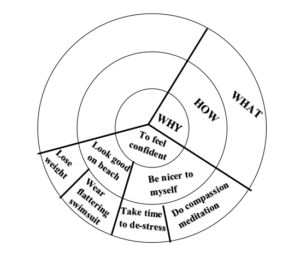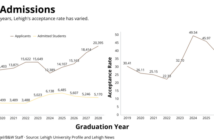
Karen Konkoly
Eating celery all day? Drinking absurd amounts of water? Going to every fitness class the gym offers?
I never hear my friends talk about vegetables more than in the months leading up to spring break. Even for people who usually avoid dieting, it can be difficult to continue a normal health routine knowing in a month you’ll be posing for a bikini picture with friends who haven’t skipped a day of barre class since January.
Although my friends continually reiterate their goal to lose weight for spring break, I don’t think losing weight is really what the goal is about.
To me, it sounds like code for some higher priority. I suspect they are really trying to look good in Facebook pictures to impress their obnoxious cousins or rock their favorite pair of short shorts that got a little too tight after Thanksgiving.
And in an achievement-oriented culture like Lehigh’s, there tends to be a lot of advice about goal setting for success.
Make your goals specific and quantifiable. Challenging but attainable. Break them up into sub-goals so you can check your progress along the way. Tell a friend to keep you on track. Prepare for success.
These techniques are great because they maximize our chances of achieving what we think is our goal. Nowhere in this goal-setting dogma, however, do we learn how to choose our goals themselves.
Because of this, even if we follow through completely and drink two cups of water before every meal to achieve our goal of weighing exactly 6.5 pounds less by March 13, we still might feel self-conscious on the beach. We might look awkward and pale next to the barre class queen.
If we achieve a goal and we’re still not satisfied, it’s tempting to just move the goalpost farther away. By next year this time we’ll have a six-pack, and then we’ll feel confident. Right?
Even achieving large goals can leave us feeling empty.
My friend and I recently ran a marathon and discovered what many runners call the post-marathon blues. The end of the marathon meant we had finally accomplished the goal we’d been working toward for months, yet we felt lackluster and aimless.
If the goal really was to just finish the marathon, then maybe we would feel satisfied. If the real goal was to feel up to snuff with our ridiculously athletic sisters, however, just running a marathon won’t guarantee that goal is met. Accomplishing the deeper goal might require other steps, like developing better self-acceptance and a better appreciation for the variety of talents in a family.
Running a marathon is a great accomplishment, but it won’t automatically lead to happiness if it’s not what we were actually trying to accomplish.
I contend a new dogma of goal setting is in order that takes attention away from the ever-moving goal posts and focuses our attention on what we are actually trying to achieve. To help myself do this, I started mapping out goals in a three-layered pie chart that borrows an idea from Simon Sinek’s TED talk on his book, titled “Start With Why.”
Sinek proposes that successful businesses focus first on why they are doing what they’re doing, focus second on how they are going about addressing that why, and focus last on what they are actually producing.
He illustrates this with the “golden circle,” an image of three concentric circles. The center circle contains why we want to achieve a certain goal, the circle around it contains how we go about achieving it, and the largest circle contains what we actually plan to do.

An example of a golden circle.
I’ve found the golden circle provides the perfect template to critically analyze personal goal systems as well.
When I started thinking about my personal situation, I realized some of my goals were really just the hows and whats of deeper, more profound motivations. Whenever I think I’ve set a goal, I always try to ask myself why, and if I can’t think of an answer I ask again until I get at the heart of what I truly hope to achieve.
Tracing goals back to their origins allows us to ensure there is a logical progression from why to how to what. Further, it helps put priorities in perspective. Even if you don’t end up losing 6.5 pounds by March 13, that might only be a tiny sliver on the edge of your circle.
A “goal”den circle map allows us to check our daily priorities against the big picture and orient our behavior toward ends that are truly fulfilling.
—
Karen Konkoly, ’17, is a columnist for The Brown and White. She can be reached at [email protected].





Comment policy
Comments posted to The Brown and White website are reviewed by a moderator before being approved. Incendiary speech or harassing language, including comments targeted at individuals, may be deemed unacceptable and not published. Spam and other soliciting will also be declined.
The Brown and White also reserves the right to not publish entirely anonymous comments.